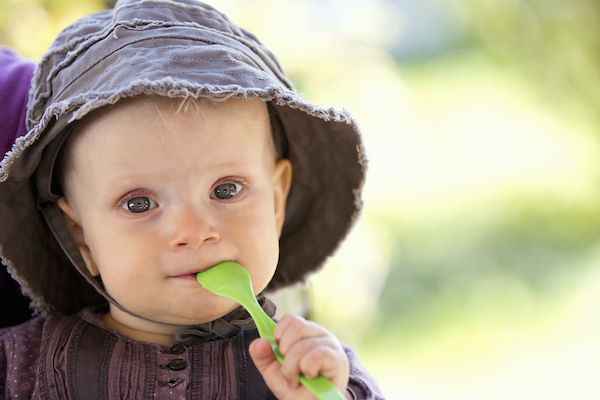 Teething happens when a baby’s primary teeth push through the gums into the baby’s mouth. For some babies, teething is uncomfortable. Head Start staff can support parents with a baby who is teething.
Teething happens when a baby’s primary teeth push through the gums into the baby’s mouth. For some babies, teething is uncomfortable. Head Start staff can support parents with a baby who is teething.
This Brush Up on Oral Health tip sheet provides information on teething and offers tips for Head Start staff to share with parents to comfort their baby who has teething pain.
Most babies begin teething around age 6 months, but teething can start any time between ages 3 and 12 months. As the primary teeth come into the mouth, babies may feel pain from the tooth pushing through the gum. Babies who are teething may become cranky, drool more, have red and swollen spots on their gums, and chew on things more frequently.
Tips for Parents to Ease Baby’s Teething Pain

- Clean it. Many strategies for comforting a teething baby include putting something in the baby’s mouth. Everything that goes in the mouth should be cleaned first to keep the baby healthy. Read the package for directions on how to clean the item. Some items are dishwasher safe, and some are not.
- Massage it. Gently rub the baby’s gums with a clean finger for about two minutes. Many babies find the pressure soothing. For babies who already have some teeth, be careful the baby doesn’t bite you!
- Cool it. Cold helps ease the pain of sore gums. Give the baby a cool clean wet washcloth, spoon, pacifier, or teething ring to chew on. Teething rings can be put in the refrigerator but not the freezer. Chewing frozen teething rings can make a baby’s cheeks or chin become bumpy and turn reddish-purple. Note: To prevent injuries to the mouth, do not let a baby walk while holding a spoon.
- Don’t use it. Over-the-counter teething gels and liquids on babies’ gums are not recommended because they offer little to no benefit for treating oral pain. They all contain benzocaine, which if used incorrectly can cause serious health problems, including blood disorders and death. If nothing works to ease a baby’s teething pain, ask the baby’s doctor or dentist for directions on what pain medications can be used and how to use them safely.
In addition to the suggestions given above, share Healthy Habits for Happy Smiles: Helping Your Baby with Teething Pain with parents to reinforce your conversations with them. The American Academy of Pediatrics also has information and tips that can help parents comfort a baby who is teething.
It is important to remember that once a tooth comes into the mouth, the tooth is at risk for developing tooth decay. Encourage parents to brush their child’s teeth using an infant-sized toothbrush with soft bristles with a rice-size amount of fluoride in the morning and before bedtime.
Download a PDF version to print and share.
Read more:
Resource Type: Article
National Centers: Health, Behavioral Health, and Safety
Audience: Teachers and Caregivers
Series: Brush Up on Oral Health (BUOH)
Last Updated: April 26, 2023
